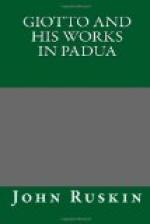THE COMPLETE WORKS
OF
JOHN RUSKIN
VOLUME X
Giotto and his works
lectures on architecture
the harbors of England
political Economy of art (A joy
forever)
GIOTTO
AND HIS WORKS IN PADUA
BEING
An explanatory notice of the
series of
woodcuts executed for the Arundel
society after the frescos in
the Arena chapel
ADVERTISEMENT.
The following notice of Giotto has not been drawn up with any idea of attempting a history of his life. That history could only be written after a careful search through the libraries of Italy for all documents relating to the years during which he worked. I have no time for such search, or even for the examination of well-known and published materials; and have therefore merely collected, from the sources nearest at hand, such information as appeared absolutely necessary to render the series of Plates now published by the Arundel Society intelligible and interesting to those among its Members who have not devoted much time to the examination of mediaeval works. I have prefixed a few remarks on the relation of the art of Giotto to former and subsequent efforts; which I hope may be useful in preventing the general reader from either looking for what the painter never intended to give, or missing the points to which his endeavours were really directed.
J.R.
GIOTTO
And his works in Padua.
Towards the close of the thirteenth century, Enrico Scrovegno, a noble Paduan, purchased, in his native city, the remains of the Roman Amphitheatre or Arena from the family of the Delesmanini, to whom those remains had been granted by the Emperor Henry iii. of Germany in 1090. For the power of making this purchase, Scrovegno was in all probability indebted to his father, Reginald, who, for his avarice, is placed by Dante in the seventh circle of the Inferno, and regarded apparently as the chief of the usurers there, since he is the only one who addresses Dante.[1] The son, having possessed himself of the Roman ruin, or of the site which it had occupied, built himself a fortified palace upon the ground, and a chapel dedicated to the Annunciate Virgin.
[Footnote 1:




